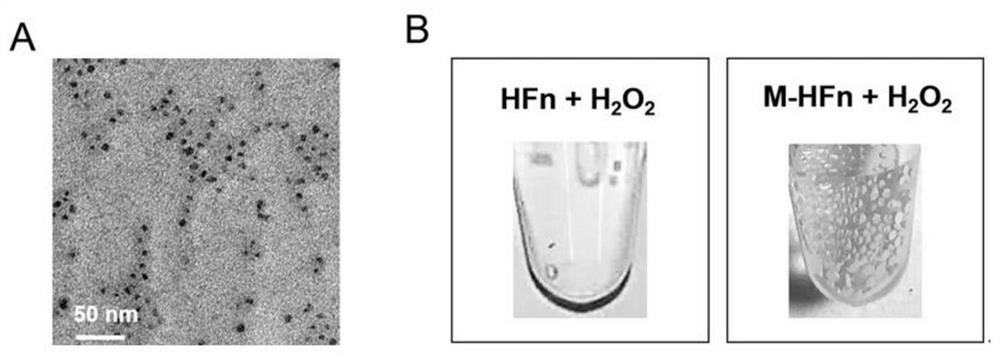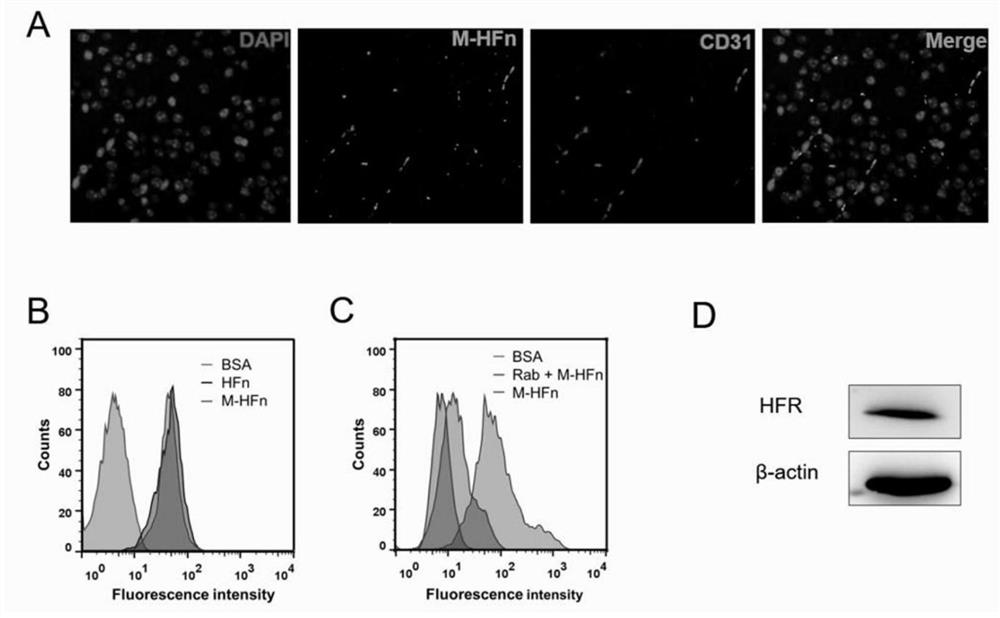Novel reagent and method for treating malignant cerebral malaria
A brain type and preparation technology, applied in the intersection of immunology and biomedicine, nanotechnology, and bionics, can solve the problems of not being able to relieve symptoms in a timely manner, and having no targeted therapeutic effect
- Summary
- Abstract
- Description
- Claims
- Application Information
AI Technical Summary
Problems solved by technology
Method used
Image
Examples
Embodiment 1
[0048] Embodiment 1. Preparation of ferritin nanozyme
[0049] Natural human ferritin is a globular iron storage protein composed of 24 heavy chain or light chain subunits in any proportion. The heavy chain and light chain subunits have high homology, and the molecular weights are 21kDa and 19kDa respectively (Theil EC., (1987) Annu. Rev. Biochem., 56:289-315). The subunit composition of ferritin in different organs and tissues of the human body is different. The heavy chain subunit is the main component in the heart, while the light chain subunit is more in the liver. Flexible supply of iron ions. However, only the heavy chain subunit can use oxygen to convert ferrous ions into ferric ions, so that iron ions can enter ferritin smoothly, so increasing the heavy chain subunit can increase the ability of the cell to utilize iron; while the light chain Subsequent to yacidol, it can increase the efficiency of iron storage. In the spherical shell of ferritin, iron ions form crys...
Embodiment 2
[0054] Example 2. Catalase activity of ferritin nanozymes
[0055] Based on the report of Fan Chunhai's research group, magnetic iron oxide nanoparticles have catalytic activity similar to catalase [12] , since ferritin is wrapped with an iron oxide inner core, it should have catalase-like activity, which can decompose hydrogen peroxide to generate oxygen. We used hydrogen peroxide to detect the enzymatic activity of ferritin nanozyme as follows: add 0.5mM H to ferritin nanozyme 2 o 2 React in PBS (pH=7.4) at 37° C. for 5 minutes, and observe the generation of bubbles. Such as figure 1 B, when ferritin nanozyme (Fenozyme) and H were added into the EP tube 2 o 2 After that, a large number of bubbles were generated in the liquid, but the ferritin shell (HFn) did not decompose hydrogen peroxide, indicating that the ferritin nanozyme had catalase-like activity.
Embodiment 3
[0056] Example 3. Ferritin Nanozyme Binding to Brain Microvascular Endothelial Cells
[0057] In order to study the binding of ferritin nanozyme to mouse microvascular endothelial cells, paraffin sections of mouse brain tissue and mouse brain microvascular endothelial cell line bEnd.3 were selected for incubation with fluorescent molecularly labeled ferritin nanozyme, and laser confocal microscopy was used and flow cytometry to detect the binding of ferritin nanozyme to brain microvascular endothelial cells.
[0058] The experimental method is as follows: according to the labeling method provided in the instructions, NHS-activated FITC (FITC-NHS, purchased from GE Healthcare) was labeled on ferritin nanozyme. Dewaxing according to the immunofluorescence steps of paraffin sections: take out the slices, and put them into xylene solution twice, 10 minutes each time; Hydration in neutral, 3 minutes per step; 0.01M (pH6.0) citric acid buffer, 100°C water bath for 30 minutes to rep...
PUM
| Property | Measurement | Unit |
|---|---|---|
| Diameter | aaaaa | aaaaa |
| The inside diameter of | aaaaa | aaaaa |
| Molecular weight | aaaaa | aaaaa |
Abstract
Description
Claims
Application Information
 Login to View More
Login to View More - R&D
- Intellectual Property
- Life Sciences
- Materials
- Tech Scout
- Unparalleled Data Quality
- Higher Quality Content
- 60% Fewer Hallucinations
Browse by: Latest US Patents, China's latest patents, Technical Efficacy Thesaurus, Application Domain, Technology Topic, Popular Technical Reports.
© 2025 PatSnap. All rights reserved.Legal|Privacy policy|Modern Slavery Act Transparency Statement|Sitemap|About US| Contact US: help@patsnap.com



